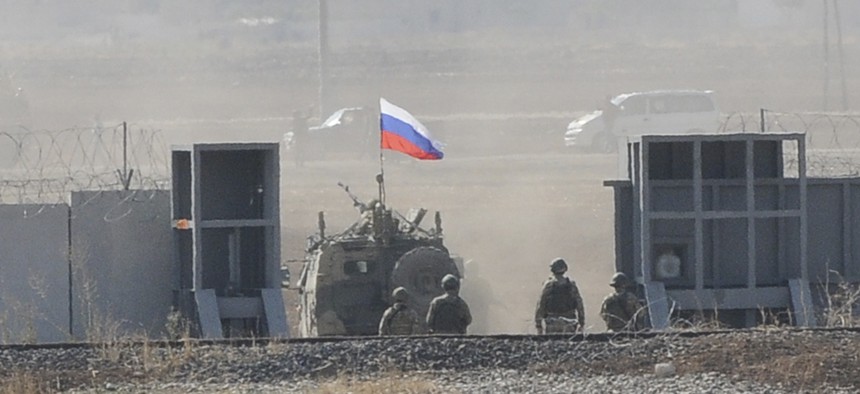
In this photo taken from the outskirts of Suruc, southeastern Turkey, Russian and Turkish forces enter Syria, as they begin their joint patrol, Tuesday, Nov. 5, 2019. AP Photo/Mehmet Guzel
The Mad Scramble for Syria
After weeks of chaos in the northeast, great powers redrew a small chunk of the map. And a bigger story is just beginning.
The U.S. pulled back. Turkey moved in. Kurdish forces retreated. The Syrian government gloated. Russia struck a deal and sent in more troops. More than 100 people died and more than 100,000 fled.
All this happened over a few weeks in October across a long but narrow strip of Syrian land running 300 miles along the Turkish border. It looked like a 21st-century great-power scramble to redraw the map. In reality, not much territory changed hands. So after almost a month of chaos, the U.S. is caught in a new maelstrom of competing proxies, its weak leverage further damaged, and the future of its anti-Islamic State fight thrown into doubt.
The supposed winners—Turkey, Russia, and the Syrian regime—have gained some slapdash spheres of influence and a severe hit to American prestige. The losers, as ever, are Syrian civilians.
The U.S. military, with President Donald Trump’s repeated seesaws over whether to stay or go in Syria, now must keep up the fight against ISIS with fewer troops and local Kurdish partners, who may no longer trust it.
Related: The US Might Have Warded Off Turkey’s Syria Invasion, Says DOD’s Outgoing Mideast Policy Chief
Related: The Intelligence Fallout From Trump’s Withdrawal in Syria
Related: 10 Hard Realities of America’s Next Syria Policy
Meanwhile, the vacuum along the border has given way to a patchwork of outside forces and the proxies they back. “There’s so many armed forces driving around with different flags,” Steve Gumaer, president of the aid organization Partners Relief & Development, who recently returned from a visit to northeastern Syria, told me. He said members of his team saw two Syrian personnel carriers, as well as Russian carriers, Turkish tanks, and vehicles of the Free Syrian Army, the militias Turkey relied on to help push back the Kurds. Perhaps some 30 groups or factions make up the Turkish-backed proxy forces operating there, according to Oula Alrifai, a fellow at the Washington Institute for Near East Policy, citing Kurdish sources. These include Islamist extremists. “Some elements,” she told me, “are more radical than others.”
And in a sign of the chaotic trajectory of U.S. policy in Syria’s civil war, some of the militias now backed by Turkey were once American proxies, meaning America’s former partners have proved quite effective at helping dislodge their current ones. As Michael Kofman, an expert on the Russian military at CNA, put it to me: “It’s actually U.S. proxies attacking U.S. proxies on behalf of a U.S. ally,” Turkey.
Yet the losses aren’t as great as they could have been. The Kurdish-led Syrian Democratic Forces remain in control of much of northeastern Syria, and nearly all of its resources, including oil and gas. Kurdish militias have pulled back from a strip along the border but, except for a roughly 75-mile chunk in the middle that’s now controlled by Turkish proxies, their governance structures remain in place, according to a U.S. official who spoke on background, and Dareen Khalifa, an analyst for the International Crisis Group who visited the region recently.
Crucially, these include the major detention camps for ISIS fighters—despite initial fears that the SDF would stop guarding those prisons to focus on self-defense against Turkey, so far it remains in control of thousands of suspected ISIS fighters. Feared mass prison breaks from those facilities never materialized, although Secretary of Defense Mark Esper at one point admitted that perhaps as many as 100 fighters got free. (Trump has since tweeted that Turkey captured “numerous” escaped fighters—plus the wife and sister of the late ISIS leader Abu Bakr al-Baghdadi, killed in a U.S. raid in October.)
And though Syrian President Bashar al-Assad has vowed to take back “every inch” of his country, he still lacks the forces to do it. The Russians have deployed a few hundred troops to help patrol the Turkish border, but it’s too long for them to fully monitor and, according to Kofman, they don’t want to be there much more than the Americans do. “It’s actually an added burden to them,” he told me.
As for the Turks, they’ve achieved their key goals of pushing Kurdish militias away from their border, obviating what Turkish President Recep Tayyip Erdoğan has characterized as a security threat due to those militias’ ties to Kurdish militants within Turkey. But the remaining strength of the Syrian Democratic Forces has left intact the political threat of an autonomous Kurdish zone standing as an example to Turkey’s own Kurdish population.
Throughout, one major dynamic has stayed consistent: The future of Syria depends as much on foreign powers as on the Syrians themselves. This was clear in the cease-fire negotiations of October—in which both Russia and the United States struck separate deals with Turkey, and without any Syrians formally signing on to either agreement.
The U.S. has shifted where it is in Syria, but not what it wants. Esper has said that keeping ISIS defeated is still the goal, and the military keeps issuing a steady stream of press releases about counter-ISIS actions in Syria. Now, however, Trump has added the mission to “guard the oil” in eastern Syria; the oil fields at issue, too, have been and remain under the control of the SDF.
So the U.S. retains enough of a presence to influence events somewhat, particularly by providing air cover to its local Kurdish-led partners against ISIS (although not, importantly, against America’s NATO ally Turkey, whose proxies continue to battle the Kurds in some areas despite the cease-fires). As a combatant in Syria’s civil war, the U.S. has some leverage in negotiations over how it all ends, but to a lesser degree than Russia, Turkey, and Iran, who collectively have invested more in Syria.
It is also now in a stronger relative position to make demands in any future negotiations to settle Syria’s fate. Russia will seek to preserve a role for its ally Assad; Turkey will seek to further undermine Kurdish aspirations in the country. Neither of these things may be in American interests, but Donald Trump has made clear that he sees America’s main interest as leaving.
The clear losers are again the ordinary Syrians, condemned to flee their homes or risk death in the cross fire of the ever-shifting battlefield their home has become.




